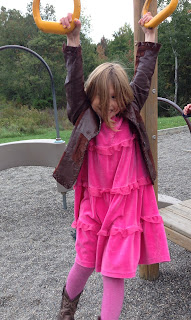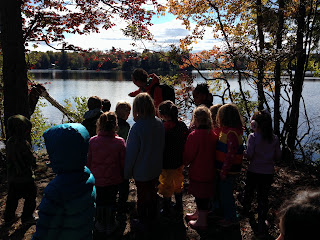We have noticed many new friendships blooming in the crisp, autumn breeze. Many of our morning meetings have been devoted to discussing how to handle the new and often challenging dynamics of friendship. Helping children move between friends on a weekly and daily basis is a lesson in flexibility for all of us. Young children can have a very difficult time recognizing social cues sent by their peers.
The most common complaints we hear are that “Mary” either won’t play with me or isn’t my friend anymore. There are a couple of directions we could take with these statements. The first is to call over the other student and directly handle the issue, attempting to solve the dilemma for all involved. The second, and more commonly used within the Responsive Classroom approach, is to meet with the affected parties and oversee a discussion in which they solve their own problems.
We encourage the children to tell each other what they are thinking and feeling. Young children (and even adults) often forget to take the other person’s perspective into consideration when weighing an issue. The emotionally injured child frequently finds that the offending party simply “went off to play somewhere else,” not even realizing that someone was left behind. At other times, we discover that the child didn’t truly ask “Sally” if she wanted to play. Instead, the child stood near “Sally” and was disappointed when “Sally” wandered off. Often children perceive there is a huge social injustice going on when in fact the offending party didn't even realize they were in the midst of game!
Perspective taking is not something we expect our four, five and six year-old students to master. In fact, it is a skill humans continue to work on throughout life. We can help our students to use language to express their own perspective. Vocalization both cements their personal understanding of a situation and allows others to consider a differing point of view. Being able to talk about a problem with a friend is a skill that will be necessary over a lifetime. It's our goal to give children the tools needed to navigate these tricky social waters.
Wednesday, October 21, 2015
Wednesday, October 14, 2015
Dyken Pond
We had a spectacular day at Dyken Pond last week. After what seemed like a rather long bus ride over some very windy country roads, we arrived to a beautiful Fall day at the pond. We were greeted by two excellent educators, Ian and Casey, who gave us a guided tour of the property, pointing out signs of animal life along the way. We stopped by the lake to learn about differences between lakes and ponds, and about the animals who live there.
We paused along the way to notice a dusky salamander and the telltale signs of beaver activity. Ian and Casey talked about the animals that live near the lake and gave us the opportunity to see and touch different animal furs (fox, beaver, and bobcat). The children also got to see the large shell of a snapping turtle and the skull of a beaver - both items that generated lots of ooohs and aaahhhs from the group.
We ended the hike by hearing various bird calls and looking out for these specific birds on our way back. After a picnic lunch with friends, we gathered together for habitat relay races and a rousing game of "Bat and Moth" where kids took on the role of either a bat or a moth - exploring the idea of echolocation. We ended the trip with a careful observation of the pond and last look around at the gorgeous fall foliage. The children returned to school tired and happy, asking when our next field trip will be. ;)
 |
| A stunning view of the lake |
 |
| View from the rocks |
 |
| Look what I see! |
We paused along the way to notice a dusky salamander and the telltale signs of beaver activity. Ian and Casey talked about the animals that live near the lake and gave us the opportunity to see and touch different animal furs (fox, beaver, and bobcat). The children also got to see the large shell of a snapping turtle and the skull of a beaver - both items that generated lots of ooohs and aaahhhs from the group.
We ended the hike by hearing various bird calls and looking out for these specific birds on our way back. After a picnic lunch with friends, we gathered together for habitat relay races and a rousing game of "Bat and Moth" where kids took on the role of either a bat or a moth - exploring the idea of echolocation. We ended the trip with a careful observation of the pond and last look around at the gorgeous fall foliage. The children returned to school tired and happy, asking when our next field trip will be. ;)
 |
| A salamander |
 |
| Checking out the pond |
 |
| Peak Fall foliage! |
Sunday, October 4, 2015
Taking Risks
The first few weeks of school are filled with risks. All of us, from the K-1 student to the most experienced teacher, feel this. Our children have to navigate a new set of routines, manage new personality dynamics, make friends, keep friends, decipher the emotional tone of their new class, and figure out where they fit within this new community. Taking acceptable risks when steering through all of this can be daunting. Grown-ups can put it into words, “What if I fail?” Children usually aren’t able to put it so succinctly.
In the classroom and beyond, a child chooses whether or not these risks are worth it:
- Waiting for a teacher to call on them
- Calling out the answers
- Speaking up for their own rights (i.e. I don’t like this game. I want to play something different.)
- Asking to go to the bathroom
- Saying goodbye to a parent
- Raising a hand during meetings
- Attempting to write their name or other words
- Drawing a picture
- Joining a group or single friend in play
- Reading aloud to a classmate
- Crossing the monkey bars or rings on the playground
We want our children to be comfortable taking the risks that promote growth. It is for this reason that we create an environment that welcomes mistakes, experiments, discussion, and observation. All of the children in our room are capable of great things. We want to make sure they are willing to build the attempts to get them there.


Subscribe to:
Posts (Atom)









